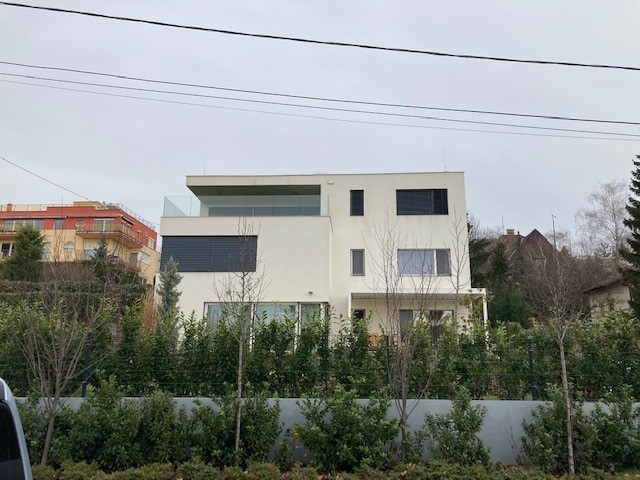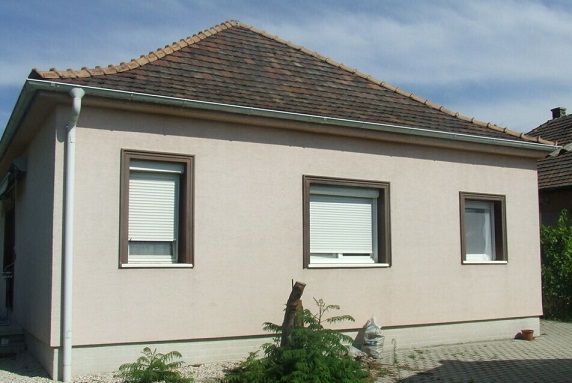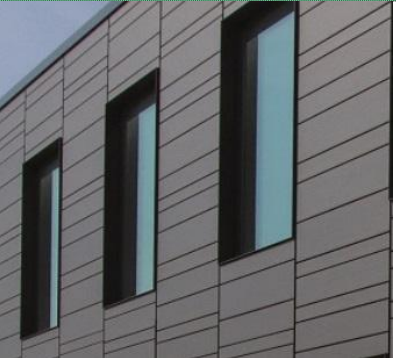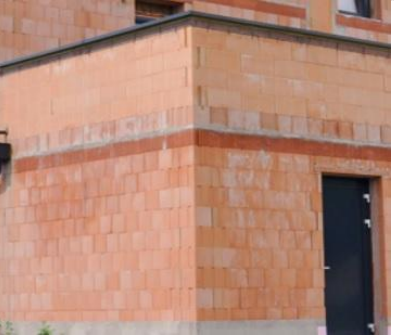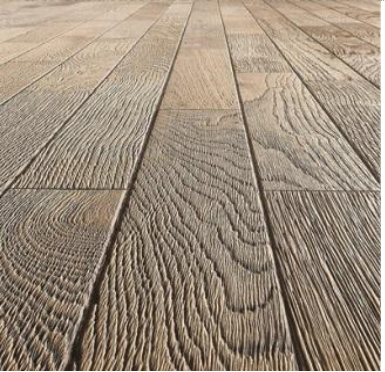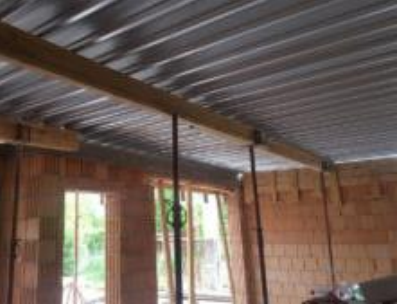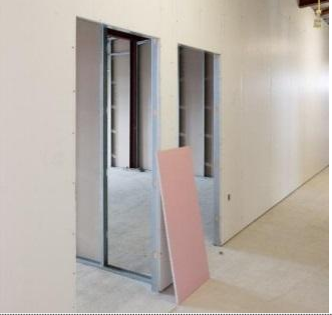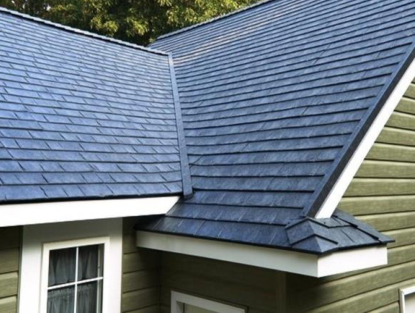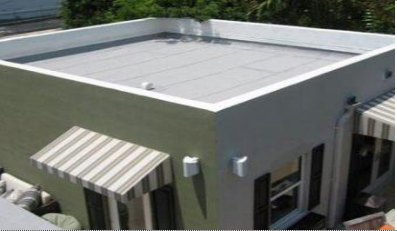BUILDING CASE STUDY 1: New Hungarian two-dwelling house
The case study building is a newly built house for two families with high quality materials. The building has a basement + 3 storeys and flat roof.
Building type: two-dwelling house
Net heated floor area: 467,01 m2
Building type: two-dwelling house
Net heated floor area: 467,01 m2
BUILDING CASE STUDY 2: Energy retrofit of a Hungarian detached house
The case study building is a typical Hungarian detached house, built with a nearly rectangular floor plan of approx. 100 m2 and a pyramid hip roof. These buildings were built in large volumes between the 1950s and the 1970s, there are approx. 800 000 of them all around Hungary. Their nickname is “Kádár cube”, named after a Hungarian communist leader of the period.
Net heated floor area: 91 m2
Gross floor area: 105 m2
Net heated floor area: 91 m2
Gross floor area: 105 m2
Carbon footprint limits for common Finnish building types
Report on Carbon Footprint Limits for Common Building Types,
commissioned by the Finnish Ministry of Environment.
Italian envelopes comparison
This case study deals with the carbon footprint assessment of technological solutions for the envelope of buildings
in Italy with the following major objectives:
• To illustrate 3 typical envelope solutions suitable for a Mediterranean context, like Italy is
• To illustrate how to build up the comparison of different solutions
• To illustrate the (screening) analysis of high-performance envelope solutions and provide examples/guid on how to interpret life cycle assessment results.
• To illustrate 3 typical envelope solutions suitable for a Mediterranean context, like Italy is
• To illustrate how to build up the comparison of different solutions
• To illustrate the (screening) analysis of high-performance envelope solutions and provide examples/guid on how to interpret life cycle assessment results.
Claddings - Hungary
Compared options:
Brick facade cladding
Stone facade cladding
Ceramic facade cladding
Wooden facade cladding
HPL board facade cladding
Brick facade cladding
Stone facade cladding
Ceramic facade cladding
Wooden facade cladding
HPL board facade cladding
External walls - Hungary
Compared options: Hollow ceramic block (25NF) wall with EPS insulation, Hollow ceramic block (30NF) wall with EPS insulation, Hollow ceramic block (30NF) wall with grey EPS insulation, Hollow ceramic block (30NF) wall with mineral wool insulation, Hollow ceramic block (30NF) wall with wood wool insulation, Hollow ceramic block wall (38 cm), Aerated concrete wall (37.5 cm), Aerated concrete wall (25 cm) with EPS insulation, Sand lime brick (30 cm) with EPS insulation
Sand lime brick (30 cm) with calcium silicate insulation, Wood stud wall with mineral wool insulation, Adobe wall with straw insulation
Floor finishes - Hungary
Compared options:
Ceramic tiles,
Solid wooden floor,
Multi-layer wooden floor,
Laminated floor, incl. underlay,
Vinyl floor covering,
Linoleum floor covering,
Carpet floor covering,
Natural stone floor
Floor slabs - Hungary
Compared options:
Precast concrete beam slab with ceramic cladding and ceramic infill blocks
Precast concrete beam slab with concrete infill blocks
In-situ concrete slab
Aerated concrete reinforced floor panel slab
Wooden joist floor
Precast concrete beam slab with ceramic cladding and ceramic infill blocks
Precast concrete beam slab with concrete infill blocks
In-situ concrete slab
Aerated concrete reinforced floor panel slab
Wooden joist floor
Internal walls - Hungary
Compared options:
Hollow brick partition wall
Aerated concrete partition wall
Sand lime brick partition wall
Gypsum board partition wall with mineral wool
Gypsum board partition wall with glass wool
Adobe partition wall
Wood stud wall partition wall
Hollow brick partition wall
Aerated concrete partition wall
Sand lime brick partition wall
Gypsum board partition wall with mineral wool
Gypsum board partition wall with glass wool
Adobe partition wall
Wood stud wall partition wall
Pitched roofs - Hungary
Compared options:
Heated pitched roof with wooden rafters, mineral wool insulation and ceramic roof tiles
Heated pitched roof with wooden rafters, mineral wool insulation and concrete roof tiles
Heated pitched roof with wooden rafters, mineral wool insulation and asphalt shingle roofing
Heated pitched roof with wooden rafters, mineral wool insulation and titanium zinc roofing
Heated pitched roof with wooden rafters, mineral wool insulation above rafters and ceramic roof tiles
Heated pitched roof with wooden rafters, grey EPS insulation above rafters and ceramic roof tiles
Heated pitched roof with wooden rafters, PUR insulation above rafters and ceramic roof tiles
Heated pitched roof with wooden rafters, mineral wool insulation and ceramic roof tiles
Heated pitched roof with wooden rafters, mineral wool insulation and concrete roof tiles
Heated pitched roof with wooden rafters, mineral wool insulation and asphalt shingle roofing
Heated pitched roof with wooden rafters, mineral wool insulation and titanium zinc roofing
Heated pitched roof with wooden rafters, mineral wool insulation above rafters and ceramic roof tiles
Heated pitched roof with wooden rafters, grey EPS insulation above rafters and ceramic roof tiles
Heated pitched roof with wooden rafters, PUR insulation above rafters and ceramic roof tiles
Flat roofs - Hungary
Compared options:
lat roof with reinforced concrete slab, EPS insulation and bituminous waterproofing, Flat roof with aerated concrete reinforced concrete panels, EPS insulation and bituminous waterproofing, Flat roof with precast concrete beams and ceramic infill blocks, EPS insulation and bituminous waterproofing, Flat roof with reinforced concrete slab, grey EPS insulation and bituminous waterproofing, Flat roof with reinforced concrete slab, mineral wool insulation and bituminous waterproofing, Terrace roof with reinforced concrete slab, XPS insulation and bituminous waterproofing, Unheated pitched roof with ceramic roof tiles + reinforced concrete slab with EPS insulation, Unheated pitched roof with ceramic roof tiles + reinforced concrete slab with mineral wool insulation, Unheated pitched roof with ceramic roof tiles + reinforced concrete slab with cellulose blown-in insulation, Unheated pitched roof with ceramic roof tiles + aerated concrete reinforced floor slab with EPS insulation, Unheated pitched roof with ceramic roof tiles + floor slab with precast concrete beams and ceramic infill blocks, EPS insulation, Unheated pitched roof with ceramic roof tiles + wooden joist loft floor with mineral wool insulation
lat roof with reinforced concrete slab, EPS insulation and bituminous waterproofing, Flat roof with aerated concrete reinforced concrete panels, EPS insulation and bituminous waterproofing, Flat roof with precast concrete beams and ceramic infill blocks, EPS insulation and bituminous waterproofing, Flat roof with reinforced concrete slab, grey EPS insulation and bituminous waterproofing, Flat roof with reinforced concrete slab, mineral wool insulation and bituminous waterproofing, Terrace roof with reinforced concrete slab, XPS insulation and bituminous waterproofing, Unheated pitched roof with ceramic roof tiles + reinforced concrete slab with EPS insulation, Unheated pitched roof with ceramic roof tiles + reinforced concrete slab with mineral wool insulation, Unheated pitched roof with ceramic roof tiles + reinforced concrete slab with cellulose blown-in insulation, Unheated pitched roof with ceramic roof tiles + aerated concrete reinforced floor slab with EPS insulation, Unheated pitched roof with ceramic roof tiles + floor slab with precast concrete beams and ceramic infill blocks, EPS insulation, Unheated pitched roof with ceramic roof tiles + wooden joist loft floor with mineral wool insulation
Hungarian building constructions - methodology
For the Hungarian context, typical building constructions have been defined and
analysed with LCA and additionally with life cycle costing (LCC). This document describes the methodological background of these Hungarian building constructions, related LCA/LCC case studies and their usage in the WebApp and Handbook.





